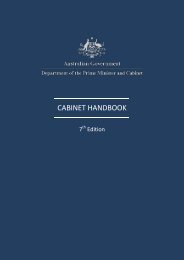Address by Ian Watt to IPAA 04 October 2012 - The Department of ...
Address by Ian Watt to IPAA 04 October 2012 - The Department of ...
Address by Ian Watt to IPAA 04 October 2012 - The Department of ...
You also want an ePaper? Increase the reach of your titles
YUMPU automatically turns print PDFs into web optimized ePapers that Google loves.
<strong>The</strong> priorities ten years later reflect a greater international focus, new technologies and a<br />
different social inclusion agenda. For example, the Australia in the Asian Century White<br />
Paper; Australia’s role in supporting security transition in Afghanistan; the National<br />
Broadband Network; health reform, including mental health reform; the National Disability<br />
Insurance Scheme; environmental regulation reform; and preparing for G20 2014.<br />
<strong>The</strong> priorities differ, but both equally reflect those <strong>of</strong> the Prime Minister <strong>of</strong> the day.<br />
<strong>The</strong> reports also show that PM&C has grown over the decade, as the responsibility and the<br />
role <strong>of</strong> the Prime Minister has grown, as the complexity <strong>of</strong> government has grown, and as<br />
centralised implementation and implementation moni<strong>to</strong>ring has become more important <strong>to</strong><br />
governments.<br />
But one thing that hasn't changed is the leadership PM&C has shown in appointing women <strong>to</strong><br />
3<br />
senior positions. In 2000-01, 40 per cent <strong>of</strong> PM&C SES were women, it is now 43 per cent2F .<br />
I am proud <strong>of</strong> the strong female presence in senior PM&C ranks, including that four <strong>of</strong> my<br />
seven direct reports are women. I also report <strong>to</strong> three women – the Prime Minister, my EA<br />
Beryl Knox and my wife Lorraine.<br />
I am a member <strong>of</strong> the Male Champions <strong>of</strong> Change and Chair <strong>of</strong> the APS Diversity Council,<br />
roles I take very seriously.<br />
And I do so because I am committed <strong>to</strong> a public service that employs and promotes the best,<br />
and believe that the APS should be able <strong>to</strong> reflect the diversity <strong>of</strong> our community. (More on<br />
that later.)<br />
How does the APS rate?<br />
<strong>The</strong>re are around 167,000 APS employees. We are located in every state and terri<strong>to</strong>ry and in<br />
many locations around the world. This makes us one <strong>of</strong> the largest and most complex<br />
organisations in Australia, if not the largest and most complex.<br />
We employ people with a mind-boggling range <strong>of</strong> skills and qualifications. We are highly<br />
skilled, and we recruit well educated people. Thanks partly <strong>to</strong> the rapid expansion <strong>of</strong><br />
Graduate Recruitment Programs, we have over 48,000 people with graduate or equivalent<br />
qualifications or better – nearly 30 per cent <strong>of</strong> our workforce. And <strong>of</strong> those, nearly 5 per cent<br />
have Doc<strong>to</strong>rates and nearly 16 per cent have Masters qualifications.<br />
Finally, we do everything from serve on the counter at Centrelink <strong>to</strong> undertake macroeconomic<br />
forecasting; from carrying out world class defence scientific research <strong>to</strong> running a<br />
world class and low cost pharmaceutical benefits scheme; from delivering multimillion dollar<br />
aid projects in far flung corners <strong>of</strong> the world <strong>to</strong> accurately and precisely writing up the<br />
minutes <strong>of</strong> Cabinet meetings.<br />
How do we rate as a public service? In my view, pretty well.<br />
3 Internal PM&C data.<br />
4




